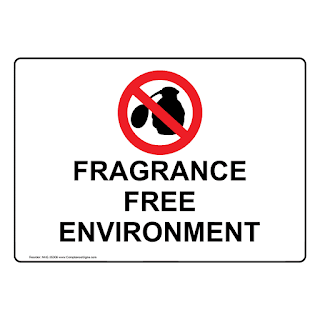Sunday, September 15, 2019
M4.5 Indoor Air Quality
Today, I'll be sharing ideas for the basis for a chemical and fragrance policy in order to eliminate and decrease our body burdens and exposures. I currently work in a hospital and although I don't have direct contact, I wonder if we actually have a fragrance policy for the employees that actually have direct patient contact.
For the hospital I work in, I would implement a fragrance free policy in the emergency room and in the department that deals with respiratory illnesses. The other parts of the hospital (Admin, laboratory, maintenance) doesn't need a strict fragrance policy, but in the overall hospital I would discourage the use of fragrances. With any policy it is helpful to provide employees with information regarding why the policy is in effect, so I would provide a fact sheet about the negative effects of fragrances on the population we serve in the hospital (typically sick).
M4.6 Radon
The more you know...
Imagine this, you never smoked, near even really been near a smoker or inhaled second hand smoke, so the last thing you want to hear from your doctor is that you have lung cancer. How is this possible?
Let me tell you how. Radon! According to the EPA and the National Cancer Institute radon inhalation at risky levels are the number cause of lung cancer amongst non-smokers. That is quite scary especially when everyone breathes radon in at some point. Based on where you live or your occupation, you could be breathing radon in at levels that will cause lung cancer. It is estimated that radon exposure causes 15,000 lung cancer deaths annually.
These numbers maybe low in comparison to the population of the United States, but these deaths are absolutely preventable, so nationally a campaign should be started in order to distribute knowledge, awareness and solutions. Some potential stakeholders I would work with would be the National Cancer Institute, the local government for cities and counties that have the most deaths or radon related incidences as well as Lung Cancer societies and groups. I would also want to work with the family members of persons that have died from radon related lung cancer.
For all my readers, please get your house checked for radon levels so that you can prevent yourself and your family members from radon induced lung cancer.
Imagine this, you never smoked, near even really been near a smoker or inhaled second hand smoke, so the last thing you want to hear from your doctor is that you have lung cancer. How is this possible?
Let me tell you how. Radon! According to the EPA and the National Cancer Institute radon inhalation at risky levels are the number cause of lung cancer amongst non-smokers. That is quite scary especially when everyone breathes radon in at some point. Based on where you live or your occupation, you could be breathing radon in at levels that will cause lung cancer. It is estimated that radon exposure causes 15,000 lung cancer deaths annually.
These numbers maybe low in comparison to the population of the United States, but these deaths are absolutely preventable, so nationally a campaign should be started in order to distribute knowledge, awareness and solutions. Some potential stakeholders I would work with would be the National Cancer Institute, the local government for cities and counties that have the most deaths or radon related incidences as well as Lung Cancer societies and groups. I would also want to work with the family members of persons that have died from radon related lung cancer.
For all my readers, please get your house checked for radon levels so that you can prevent yourself and your family members from radon induced lung cancer.
M4.2 National Library ToxNet
Greetings Readers,
Using the National Library ToxNet Click Me! I was able to find out that women who clean with bleach are at a higher risk of getting non-allergic adult-onset asthma, as well as elevated neutrophil (those are white blood cells) counts.
As far as the effects from urea formaldehyde, there are a lot of negative effects. For factory workers with exposure to urea formaldehyde there are drastic amounts of lung cancer mortality as well as nasopharyngeal cancer deaths. What I found interesting was the buccal cavity tumors and cancers. The buccal cavity is your cheek and inner mouth cavity.
I wonder if the factory managers knew about these risks and if they let the employees know about all of these risks.
Using the National Library ToxNet Click Me! I was able to find out that women who clean with bleach are at a higher risk of getting non-allergic adult-onset asthma, as well as elevated neutrophil (those are white blood cells) counts.
As far as the effects from urea formaldehyde, there are a lot of negative effects. For factory workers with exposure to urea formaldehyde there are drastic amounts of lung cancer mortality as well as nasopharyngeal cancer deaths. What I found interesting was the buccal cavity tumors and cancers. The buccal cavity is your cheek and inner mouth cavity.
I wonder if the factory managers knew about these risks and if they let the employees know about all of these risks.
Subscribe to:
Comments (Atom)
M7.8 Chlorpyrifos
The topic I am considering is chlorpyrifos (insecticide) among farmworkers. Chlorpyrifos is used to control many different kinds of pests,...
-
I currently live in Alameda County and although there are no animal farms in my county, this map shows that almost all the counties sur...
-
Well, well, well...we have moved to the topic of superbugs and antibiotics. When you think about a superbug, you probably don't think yo...
-
Greeting readers! I want to talk about campaigning against bottle water and being for TAP WATER! Yes I said it. TAP WATER! Don'...

